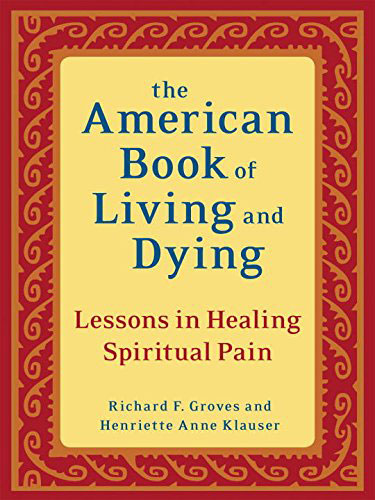American Book of Living & Dying
The American Book of Living & Dying: Lessons in Healing Spiritual Pain is co-authored by SALC founder, Richard Groves and Dr. Henriette Anne Klauser. Now in its third printing, this work has been compared to Elisabeth Kubler-Ross’ groundbreaking research on death and dying. But this is not a book about the end of life alone. The American Book of Living & Dying is ultimately a testimony to hope and living. Its lessons are about transforming suffering at any stage of life. Based on the wisdom found in the ancient books of living and dying, Groves’ work is also a collection of real life stories from persons of all cultural, social and religious backgrounds. These testimonies give us the courage to trust our deepest instincts and to discover our deepest priorities.
An Excellent Book on Healing Spiritual Pain to Live and Die in Peace, March 6, 2012
By Boyd C. Purcell (Dunbar, West Virginia)
The book written by Dr. Richard Groves and co-author Henriette Anne Klauser, “The American Book of Dying: Lessons in Healing Spiritual Pain,” is an excellent book on death, dying, and emotional healing of the pain caused by spiritual abuse. Groves made this brilliant and insightful statement about the damage caused by a sense of hopelessness, “Hopelessness pain is a terminal condition for the human spirit.” As I stated in my book, “Spiritual Terrorism: Spiritual Abuse form the Womb to the Tomb,” There is nothing which causes a greater sense of hopelessness that the overwhelming fear that God is going to punish you and/or loved ones in literal hell fire forever! This is spiritual terrorism, the most extreme form of spiritual abuse.
This well-research book draws from the rich tradition of major religions and the best in ancient cultural and religious practices to enable the dying to experience a good death that would be peaceful emotionally and spiritually painless which can also lessen, if not eliminate, physical pain. These authors cited comforting wisdom and examples from, “The Celtic Book of the Dead,” “The Egyptian Book of the Dead,” “The Gnostic Books for the Living and Dying,” “The Tibetan Book of the Dead,” and “The Monastic Books of the Dead.” They tied it all together with an astute analysis of what the books of the dead have in common. “Because the books of the dead span diverse spiritual and cultural traditions, not to mention distances of centuries and geography, we would expect differences in content and philosophy. More surprising are the similarities.” They went on to list six criterion of the common ground of collective-human experience at the end of life. These authors asked, “What is death?” and then explained, “For most of human history death was not the opposite of life, but the opposite of birth…Death has the power to heal because it has the power to put life into perspective and to bring forth life’s important priorities. The art of dying can become the art of living.”
Groves and Klauser, in the chapter, “Healing Religious Abuse and Images of God,” quoted me on my definition of such abuse, “Boyd C. Purcell defines religious abuse as ‘the act of making people believe, whether by stating or merely implying, that they are going to be punished in this life and or tormented in hell fire forever for failure to live life well enough to please God and thus earn admission to heaven.’” When correctly understood, no religion actually teaches this kind of works salvation but, as Groves wisely stated, “This interpretation is all too common.’” For the spiritually terrorized, this is what their fear-based religion has taught them. The healing balm is to discover love-based religion. In the section, “The Tool Chest,” these authors listed 18 methods for assisting the dying in healing their image of God and explained the use of these techniques to enable patients to die peacefully. This most-helpful book is well deserving of a five-star rating.

